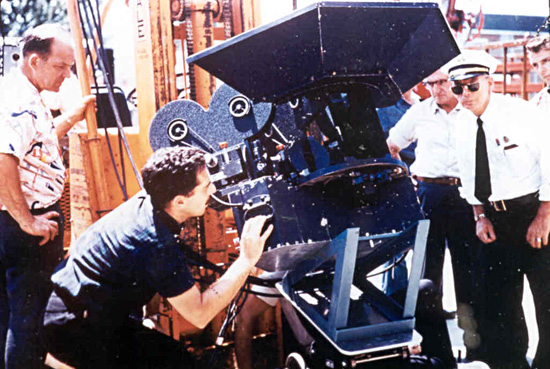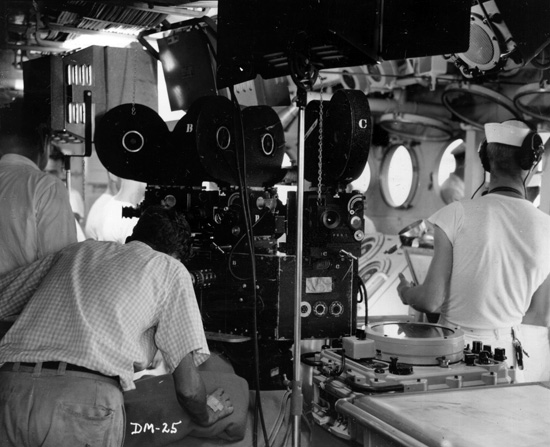Full Cinemiracle Curved Screen Presentation | Read more at in70mm.com The 70mm Newsletter | ||||||
| Written by: R. H. McCullough. Prepared for in70mm.com by: Anders M. Olsson (Sweden). | Date: 16.10.2017 | ||||||
 Tom
Conroy working with the Cinemiracle camera. Dick Babish collection Tom
Conroy working with the Cinemiracle camera. Dick Babish collectionSCREEN 1. Cinemiracle's screen ratio across screen cord is 2.33 to 1. 2. The screen is curved to the radius of the throw, which is also governed by the size of the picture. 3. We have standardized on the Hurley lenticular, flat white screen for curved screen presentation. 4. The screen width should be wall to wall for the best results. 5. Make sure that the site lines are good from every seat. 6. Fifty feet is the minimum width of a curved screen installation. 7. The maximum width is governed by the width and height of the auditorium in front of the stage proscenium. 8. We have found by experience that with a 50 foot picture, the minimum distance from the screen to the first row of seats should be around 25 feet. PROJECTION ROOM 1. We require a width of 26 feet, and 14 feet in depth, for our three Cinemiracle projectors, optical mirrors, prologue projector, rewind and film storage equipment, and sound equipment. 2. The projection throw must be more or less level with the projection screen. 3. Some theatres already have the projection room at the rear of the auditorium, which in some instances will be adaptable for our Cinemiracle equipment. 4. Where projection room facilities are not available, we have a portable projection room which is fireproof and noise proof. A similar installation has been made in the Roxy Theatre, New York City and the Opera House in Chicago. This portable projection room has been accepted by the Fire and Building Departments in each of these cities. 5. Keep in mind when a portable projection room is installed it will require a fresh air intake, lamphouse and room exhaust, and wiring. 6. The weight of our portable projection room is 6,500 pounds, which requires a good, solid foundation, without any possibility of vibration. PROJECTION EQUIPMENT 1. Remember it is possible to utilize a part of the projection equipment already in use in the theatre to be surveyed, such as projector lamps, projection lenses, rectifier or motor generator, projector for prologue reel, amplifiers, stage and surround speakers, etc. 2. The three Cinemiracle projectors are of special design. 3. The lamphouses are standard, with the exception they have to be capable of covering, without shadows, an aperture of approximately one inch in width, by one and one-eighth in height. 4. The three lamphouses for our Cinemiracle screen illumination must be capable of producing the same equal amount of light, with correct color balance. 5. We use optical mirrors for the two end Cinemiracle projectors, with remote controls for image match. 6. Four projectionists are required, one for each Cinemiracle projector and one for the sound reproducer. 7. We require one standard 35 m.m. projector for the Cinemiracle prologue reel. 8. Some of the wiring for this installation will be of a temporary nature. The cost of the electrical wiring will be governed by the length of run from the projection room location to the main distribution point. |
More in 70mm reading: "Windjammer" in Cinemiracle Sales Manual For Louis De Rochemont's Windjammer "Windjammer" Synopsis Internet link: |
||||||
 Filming
on board the US Navy vessel. Dick Pietschman Collection Filming
on board the US Navy vessel. Dick Pietschman CollectionSTEREOPHONIC SOUND EQUIPMENT 1. One 7-channel sound reproducer with preamplifiers. 2. Seven power amplifiers and front wall control and switching equipment, including volume controls. 3. Five stage speakers behind the perforated projection screen. 4. Surround speakers for auditorium and balcony. 5. The Cinemiracle sound system is all portable plug-in equipment. 6. It is possible to go into a theatre where a Todd-AO installation is in use and install Cinemiracle. Considerable saving would be effected by utilizing most of their sound equipment. 7. We can also go into theatres which have Cinemascope stereophonic sound and add to their equipment to build up to our 7-channel sound system. DRAPES AND STAGE EQUIPMENT 1. A front curtain is required, with a valance and side tormentors. 2. The front curtain follows the contour of the Cinemiracle curved screen. 3. If possible, front curtain to be remotely controlled from the projection room. 4. Front curtain requires two stop positions, one for the prologue (curtain used for prologue picture side masking) and another for the full Cinemiracle picture. 5. A top movable masking is required to be lowered for the prologue picture, also to be remotely controlled from the projection room. 6. Material for the front curtain must not be thick and heavy, but must be shirred material for the transmission of sound when the curtain is closed during overture music. 7. Avoid light colors for screen drapes. Reflections will greatly interfere with the presentation. In many theatres it is possible that some part of the projection room equipment can be used for a Cinemiracle installation. During each survey check this situation very carefully. INSTALLATION FOR FULL CINEMIRACLE This does not include ventilation, installation or wiring because the prices vary according to each individual theatre. |
|||||||
| |||||||
|
We purchase projection screens for 55˘ per square foot and this price can be used in figuring the total cost of a projection screen, using the required width and height. The screen frame for supporting a projection screen should be at least two feet larger in width and two feet larger in height to accommodate the installation of the screen. The price is 90˘ a square foot, but does not include installation, which is also estimated upon a survery of each individual theatre. This list does not include drapes, which are also subject to a survey of each individual location. Note: The foregoing estimate is based on a bare, four-wall theatre auditorium without any sound or projection equipment. However it is possible in many proposed theatres we will use rectifiers, lamps, backstage sound horns and surround auditorium speakers, sound amplifiers and perhaps the complete prologue projector, which would greatly reduce this cost, and in some instances we would use the regular projection room instead of our portable booth. |
|||||||
| Go: back - top - back issues - news index Updated 22-01-25 |
